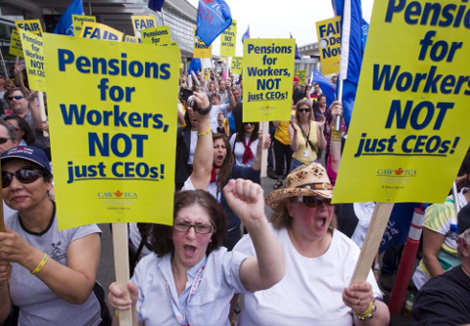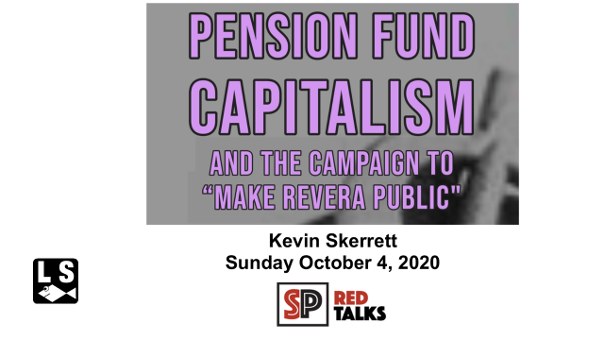Unrelenting employer attacks on workplace based pension plans are intensifying, and the struggle to defend them is becoming more challenging right across the country.
 One recent development appears to be an important partial victory. Some 900 workers at Bombardier’s Thunder Bay production facility, represented by Unifor, launched an eight-week strike on July 14, and the dispute centred on an employer demand to eliminate the secure, “defined benefit” type pension plan with an individualized “defined contribution” savings scheme for all new hires. Bombardier’s proposal was hardly a new idea – private sector employers without unions have been unilaterally imposing just that for a number of years, and it’s the model that has sparked a series of important battles at unionized private sector employers such as Vale-Inco, Air Canada, the Big Three Automakers, U.S. Steel, and many others. Even highly profitable companies have been dumping or restructuring their pension commitments to workers – all workers where possible, new hires only if necessary.
One recent development appears to be an important partial victory. Some 900 workers at Bombardier’s Thunder Bay production facility, represented by Unifor, launched an eight-week strike on July 14, and the dispute centred on an employer demand to eliminate the secure, “defined benefit” type pension plan with an individualized “defined contribution” savings scheme for all new hires. Bombardier’s proposal was hardly a new idea – private sector employers without unions have been unilaterally imposing just that for a number of years, and it’s the model that has sparked a series of important battles at unionized private sector employers such as Vale-Inco, Air Canada, the Big Three Automakers, U.S. Steel, and many others. Even highly profitable companies have been dumping or restructuring their pension commitments to workers – all workers where possible, new hires only if necessary.
In recent years, these attacks have spread into the public sector. In the period since the 2008 ‘great’ financial crisis, more and more public sector employers have been bringing these private sector pension “innovations” to universities, municipalities, and public agencies, all of which are reeling from neoliberal budget cuts of their own. The Conservative federal government has moved against the pensions of public service workers too – transferring part of their cost, and increasing the normal age of retirement on a two-tier “new hires only” basis.
Partial Victory
In light of this larger trajectory, the agreement ending the Thunder Bay Bombardier strike (ratified September 12) was a significant victory for the workers. Their deal maintained the defined benefit pension plan and retiree health insurance for all workers. But even here, the victory was qualified by a partial two-tier element – pension contributions were slightly increased for new hires only. Two-tier contracts of any sort can become permanent sources of internal divisions and weakness, and generate justified resentment of unions that accept them. (See the summary of several recent pension stories posted to Rankandfile.ca)
While some of these pressures on pension benefits emerged as long ago as the late 1980s and early 90s (especially in the U.S. and UK), the financial crisis of 2008 turned up the heat significantly by reducing pension asset valuations in virtually all Canadian defined benefit (DB) pension plans. This generated large funding gaps and appeared to give new weight to employer and right-wing think tank arguments that such plans are no longer “sustainable”. Of course, these same employers had been only too keen to drain away assets from these same pension funds in the form of “contribution holidays” that allowed them to spend what should have been their pension contributions on other things – in some cases over many years. In many cases, these contribution holidays made the 2008 stock market downturn into a major funding problem that required contribution increases for both employers and workers. This pressure intensified at just the same time that harsh austerity policies, including wage freezes, contracting out, and layoffs, were kicking in.
The impact of this on our consciousness has been complicated. Those unions and pension plan members that still have secure DB plans (in 2011, less than 25 per cent of the total labour force) have at times been reduced to anxiously hoping that financial market earnings will return to the high flying 1990s and shore up their pension fund. But the latest gloomy predictions by actuaries and other prognosticators of a long term “moderation” of investment returns are forcing the use of more conservative return assumptions in assessing plan finances, which in turn pushes pension costs even higher. (If fund investments will earn less in future, more needs to come from contributions today.) Capitalism can’t deliver, they say, so workers, once again, have to pay the price.
Radical Transformations
Meanwhile, as these battles over the quality of pension coverage have been waged over the past 20 years, the character and even the structure of financial markets and the financial instruments that are held by pension funds have been undergoing radical transformations of their own. Entirely new investment vehicles and corporate ownership arrangements have emerged, including private equity, hedge funds, derivatives, so called “emerging markets”, infrastructure (often through “public private partnerships” or P3s). These categories are now viewed as the innovative high-performance alternative to old-fashioned stocks and bonds. Many pension funds, especially the largest funds in the public sector, have moved into these areas heavily, hoping to generate greater returns with supposedly less risk.
Some analysts of this turn to a more “financialized” capitalism suggest that these changes reflect a fundamental evolution in the character of the system, leaving it both more fluid but also more laden with systemic risks. This has added to employer and government pressures on workers’ real wages and, ironically enough, pensions. Stripping pension assets from workers, especially the future workforce or “new hires”, has become a primary goal of modern finance-directed management, not just in Canada but everywhere that decent pension coverage continues to exist. The effects of this process are felt disproportionately, of course, by those least likely to have unions, or to be protected by them (including the mostly young workers hit by two-tier clauses that exclude them from the pension plan).
This ‘dispossessive’ aspect of modern management runs parallel to another one. As is widely recognized, post-crisis GDP growth has stagnated under the impact of austerity, leaving mobile financial capital to move to zones where significant profit extraction remains readily available. As indicated above, one of the most important opportunities being created or expanded is in the privatization of major public assets. A new Socialist Project pamphlet offers an especially sobering picture of how privatizations have grown in recent years around the world. The authors underline that much more is likely to come:
“…the project of total privatization is now gaining new momentum… 2012 brought about the third highest volume of privatizations by value on record, with the final tally for 2013 likely to rival the previous year’s. Britain…recently privatized Royal Mail and is looking to shed other assets like URENCO, a specialist in uranium enrichment; Japan is looking to sell Japan Post, estimated to be worth $40-billion; Australia has intimated at plans to sell its postal, financial and aviation assets…Even this briefest of listings is remarkable, and suggest that anything is possible.”1
Of course, globalized finance is not just passively cheering these policies, it is demanding them – including through the coercive apparatus used by international institutions on weaker and indebted country governments.
Here in Canada, even purportedly less austere governments are following this privatizing path, and now explicitly linking it to positive opportunities for pension fund investment. A recent visit by Ontario’s Minister of Finance Charles Sousa to the New York offices of Bloomberg generated the following report to the business press:
“The Ontario government is encouraging pension funds to invest in infrastructure from subways to prisons through public-private partnerships, Finance Minister Charles Sousa said. Funds like the Canada Pension Plan Investment Board have invested abroad and are looking at opportunities at home, Sousa said in an interview at Bloomberg’s New York headquarters.
“‘It’s not just roads and bridges, it’s hospitals, it’s prisons, it’s public transit, it’s rail, subways,’ Sousa said before giving a speech today to the Canadian Association of New York. ‘All of these initiatives are things that we’re looking at the private sector to invest.’” (Bloomberg News, 10 September 2014)
Sousa’s linkage of privatization with pension funds is not new. It is notable in this context that the $226-billion Canada Pension Plan reserve fund, originally used to help finance publicly owned infrastructure at relatively low cost, is now being invested in newly-privatized public infrastructure. Over the past 20 years, major workplace-based pension funds have also been buying up ownership stakes in a wide range of (formerly) public assets, including airports, rail lines, water treatment plants, highways and bridges, hospitals, nursing homes, energy generation and transmission, postal services and schools. These pension funds could be used as a source of finance for publicly owned and operated infrastructure – but today’s austerity-driven governments don’t want that, and neither do rate-of-return hungry pension fund managers.
Questions for the Labour Movement
These developments raise important strategic questions for the labour movement beyond just ‘how can we stop privatization and fight P3s’ (as important as that is). As pools of privately-invested pension funds continue to grow and consolidate into larger and larger entities, trade union representatives (including those on pension boards) have found themselves largely unable to exert meaningful influence on their investment practices in a way that would see them break with this overwhelming neoliberal logic. And, given the continued funding pressures on plans described above, it’s not entirely clear that unions and plan members would want them to – they are trapped by their dependency on these financial assets and structures just as workers in “dirty”, climate warming industries are dependent on their jobs and wages. We need those investment returns now more than ever, and those now stuck with individualized retirement schemes (RRSPs, defined contribution pension plans etc) understand this too. This investment market consciousness is what is now widely called “financial literacy”. But if we’re able to recognize these dependencies, could we also think through how to overcome them?
I think a strong case can be made that our continuing defence of existing pension plans needs to be even more directly linked to our expansionary agenda for the public part of Canada’s retirement income system. It’s now clear that the employer and government agenda is to significantly reduce or eliminate all remaining secure (defined benefit) pension plans, and force all workers into dependence on inefficient and insecure individual savings schemes or degraded pension plans with lesser security (so called Target Benefit plans). Doing so draws ever larger portions of workers’ savings into the hands of financial industry profiteers, who draw huge chunks out for themselves – as fees. As we know, most workers won’t be able to afford this and the prospect of a gradual return to high levels of working-class poverty and insecurity in old age is real, not only for the lowest wage and most precarious workers but the great majority.
In light of this, there may be no choice but to begin to connect the attacks on workers’ pensions with the crisis-prone and predatory financial system that pension funds operate within. But making this connection generates a number of very basic political and strategic questions: Can privately invested pension funds be disconnected from destructive financial patterns and deployed in socially positive ways? Can neoliberal capitalism be forced to provide decent pensions to all workers? Can a predatory private financial system be reformed?
Activists Discuss Pension Funds
About a year ago, I worked with a group of activists at Toronto’s Centre for Social Justice to put together a series of workshops that would try to examine these kinds of questions. At six different workshop sessions between September and December, a different panel of researchers, trade unionists, lawyers and academics each examined a sub-set of issues, and we invited union members, left activists, and students to join us for the discussions. The questions we posed were unlike most pension conferences and union educationals because they were larger and more political, and invited consideration of the fundamental character of our existing pension system, the general financial system, and capitalism itself.
Several of the sessions were especially interesting for covering fairly new ground. The second workshop subjected the field of “socially responsible investment” (SRI) and related concepts to critical scrutiny. The fourth session looked specifically at the rise of privatization, and considered the active involvement of major Canadian pension funds in financing and advancing it. The sixth and final session had Doug Henwood and Sam Gindin discussing the overall problems that had been tabled, and whether an alternative model that does not depend on conventional financial assets and markets might be developed and championed. (See below for a more detailed listing of the various sessions).
This workshop series was designed more as an attempt to provoke a needed debate rather than resolve an existing one. These are all major questions, and difficult. But the continuing attacks on Canadian workers’ pension plans, and the simultaneous expansion of an aggressive, privatizing financial sector (that includes pension fund managers) suggest that this particular set of contradictions is not going away any time soon. Working out viable alternative models for our pension system may be an urgent task not only as part of our defensive response to the attacks on pensions, but also as a means of breaking with the tendency to view our economic security as fundamentally bound up with the success and power of a financial system whose socially destructive and unsustainable character is becoming more obvious. •
The views expressed in this article belong to the author and should not be taken to represent those of the organization.
With many thanks to the Centre for Social Justice and the other co-sponsors of the series, the six workshop sessions from the Fall 2013 pension workshop were all video recorded, and each individual presentation can be found at the web links listed below:
- Session 1: From Pension Fund Socialism to Pension Fund Capitalism?
- Introduction (Greg Albo and Kevin Skerrett)
- Fred Hahn (President, CUPE Ontario)
- Jo-Ann Hannah (Director, Unifor Pension and Benefits)
- Chris Roberts (Canadian Labour Congress)
- Questions and Discussion
- Session 2: Trade Union and ‘Progressive’ Strategies – the ‘Responsible Investment’, Capital Stewardship, and ‘Pension Fund Activism’ Movements
- Introduction (Greg Albo, York University)
- Susanne Soederberg (Queen’s University)
- Jim Stanford (Economist, Unifor)
- Catherine Coumans (MiningWatch Canada)
- Questions and Discussion
- Session 3: Fiduciary Duty: A Legal Shield for Corporate Capitalism?
- Introduction (Kevin Skerrett, CUPE Research)
- Johanna Weststar University of Western Ontario
- Murray Gold and Simon Archer (Pension lawyers, Koskie Minsky)
- Questions and Discussion
- Session 4: Pension Funds and Privatization
- Introduction (Kevin Skerrett, CUPE Research)
- Natalie Mehra (Ontario Health Coalition)
- Brian O’Keefe (CUPE Ontario)
- Session 5: The Rise of Finance – What Role for Trade Unions and Pension Funds?
- John Peters Laurentian University
- Aidan Conway York University
- Michael Rafferty University of Sydney
- Questions and Discussion
- Session 6: Trade Unions, Pensions, Corporations, and the State
- Introduction (Greg Albo, York University)
- Doug Henwood (Left Business Observer)
- Sam Gindin (Socialist Project)
- Kevin Skerrett (CUPE Research)
- Questions and Discussion





